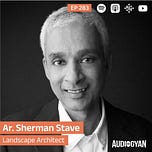In late 1800s, A Spanish architect, Antonio Gaudi, said, “There are no straight lines or sharp corners in nature. Therefore, buildings must have no straight lines or sharp corners”. But where does the nature stop and where does the building begin? Lets explore more about architecture and history in this 3 part series called, “An insert into the history”.
This series is brought to you by, The Drawing Board, with whom I had partnered last year. The Drawing Board is an international architecture platform based in India. TDB has been actively running Architecture competition for under graduate students since 2016. It is conceptualised by Mindspace Architects and Rohan Builders.
This year, the program is to redesign the existing Badami archaeological museum, in Karnataka. Submission deadline is 9th Oct 2023. More details on thedrawingboard.in
Today, in this concluding episode of this series, we have Ar. Sherman Stave with us on Audiogyan. Sherman is a Principal and Landscape Architect at STX Landscape Architects. With more than 30 years of experience. He has practised extensively in Asia and North America. His exposure to diverse cultures from an early age has lent him broad global perspective, and a deep appreciation of how shaping our environments can change our lives in fundamental ways. These are critical lenses that continue to inform his design approach.
Questions
Who is a landscape architect? What are the principles and strategies on which a landscape architect work?
BV Doshi, once said, “Is the Architecture defined by theory or it’s a convention, or it is something which is rooted in the place?” How big or small overlap do you see between the landscape and the actual building or architecture? Incase of Badami, where and how would you draw the line?
Brian O’Doherty’s famous line, “We have now reached a point where we see not the art but the space first.” What does it mean and where are you on this?
How can landscape design contribute to the interpretation and visitor experience at any archaeological site? For instance, Badami, where the landscape itself is an integral part of the site's history?
What considerations can be taken while designing architecture in such high sensitive historical landscape? When designing an archaeological site like Badami to ensure minimal impact?
Since you are staying in Singapore and even I have recently moved there, I see some amazing work done by humans. The overall landscape is well thought. Can you share your learnings and experience? How can we be so close to nature yet seems to have so much command on it?
Can you share any (2) examples of good museums or public spaces where they blend organically with nature?
Reference reading
The Drawing Board Architecture competition for Undergradute student 2024
Talk by Prashanth Pole | 27 Mar, 2021 | FA S21 Lecture series
https://www.world-architects.com/en/stx-landscape-architects-singapore/team
https://www.mnd.gov.sg/urbansustainability/webinars/liveability/abc-water-seminar-(liveability)
https://kimbellart.org/art-architecture/architecture/kahn-building
https://www.archdaily.com/61288/ad-classics-salk-institute-louis-kahn
https://www.designcurial.com/news/louis-kahn---six-most-important-buildings-4323752/
https://en.wikipedia.org/wiki/Louis_Kahn














Share this post